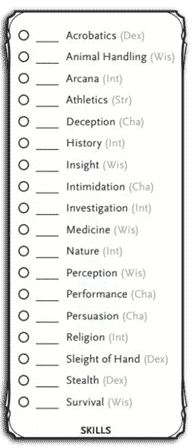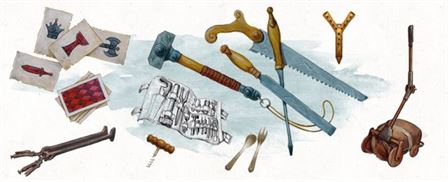[ad_1]
Updated October 10, 2020
Itn this article we continue with our series on the basics of 5th Edition of D&D, which Baldur’s Gate IIIAs an example, confirmed by Swen Vincke of Larian Studios. We will be taking a look at Proficiency, Skills and Advantage and Disadvantage, and how they apply to things mentioned in our previous article, as well as the differences between them now compared with earlier editions of Dungeons & Dragons.
Baldur’s Gate III Prep: 5th Edition D&D – Proficiency, Skills & Advantage/Disadvantage
Our website previous article, we took a look at the D20 and Abilities and how they play a huge part in the mechanics of 5th Edition D&D. They are fundamentals that all Baldur’s Gate 3 players could benefit from knowing, so if you are not familiar with them, and haven’t read that article yet, I suggest you begin there before reading this one. Otherwise, we’ll begin with Advantage & Disadvantage, and how it affects the game in 5th Edition. Visit our website. DnD GuideSection.

Advantage & Disadvantage in 5th Edition D&D
The concepts of advantage and disadvantage are fairly new. Dungeons & DragonsHe arrived in 2014 with the 5th Edition edition of D&D. This mechanic is not implemented into previous versions of the game, so this one aspect may not be familiar to many D&D players who have not played since 4th Edition.
Players will be able to choose between Advantage and Disadvantage in many situations. These can make it easier or more difficult for their character, depending on the type of advantage they are claiming. Like many things in Dungeons & Dragons, Advantage and Disadvantage are applied to the role of the D20.
Advantage refers to the ability to use either one of the lower values when rolling the D20 for an Attack Roll or Ability Check, as well as the second roll of the D20 for Saving Throw. Disadvantage is when you use the lower of both the values to roll the D20. Advantage can increase your success chances by roughly doubling them, while Disadvantage will reduce it roughly by half. If we take the scenario we used in our previous article of the party coming to a door, and add Disadvantage, let’s see what happens:
Your party and you come across a door that is impossible to open. It has a Strength DC of 15, and the doors are closed. You and your party reach a door that you cannot open. Your level 10 fighter has 18 strength, which gives him an Ability Modifier score of +4. His attempt is foiled by the wet ground which gives him disadvantage. He rolls 13 on his first roll, which would be a success under normal circumstances. He is now Disabled due to the mud so he rolls again, this time getting a 7. After a 7-roll, he opens the door but fails to get it.
Disadvantage is one of the worst situations you can be in while rolling in 5th Edition D&D, and should be avoided at all costs, while Advantage drastically improves your chances of success, and so should be sought out. Keep this in mind when making your characters, and when deciding whether or not how to proceed with situations in Baldur’s Gate 3. Now that you how Advantage/Disadvantage work, let’s move on to Proficiency, and how it applies to 5th Edition.
Proficiency & How it Works in 5th Edition D&D
All characters in D&D 5th Edition have what is called a Proficiency Bonus. It is a positive modifier which increases with character level. This works in a similar way to Ability Modifier, as it is added onto D20 rolls.
The Proficiency Bonus for each player character is +2, rising by +1 every 4 level to a maximum +6. 5th Editions has a way for you to increase your character’s power as it rises in level, increasing its chances of winning rolls. Please note that the Proficiency bonus is equal for characters with the same level, regardless if they are of the same Race or Class.
Only the D20 rolls in which you possess Proficiency are eligible for Proficiency Bonus. They are determined by your combination. RaceBackground ClassFeats. This means that you will not gain this Bonus on all of your rolls, but instead only on the things your character is “good” at. Here is a list of Proficiency items:
- You can use Attack Rolls Weapons you’re Proficient with
- Use Ability Tests Skills you’re Proficient in
- Use Ability Tests Tools you’re Proficient with
- Saving Throws you’re Proficient in
- Use spells that you cast to create Attack Rolls
- For spells that you cast, save Throw DCs
Let’s take as an example the Rogue attacking Orc mentioned in the last article. Add Proficiency Bonus to it and you get this.
Your Level 10 ElfRogue attacks an Orc with an AC of 13. Her Dexterity Modifier is +3. She’s using a Longbow. Rolling the D20, she gets an 11. Then, she adds her DEX Modifier (+3). Elves have the ability to use the Longbow proficiently so she adds her Proficiency bonus (+4). She now has a total of 18. This indicates that she hit the Orcs using her arrow. The Orc is then hit with her arrow. The +3 DEX Modifier is added to her Damage Roll, giving her a total 7 damage. A Proficiency Bonus cannot be added to Damage Roll.
You can also look at the Druid calling lightning on Goblins and factoring in Proficiency bonus. It now looks this way:
A Level 18 Druid casts the spell Call Lightning to a number of Goblins. Because his Wisdom is 23 he also has a Spellcasting Abilities Modifier of +6. This spell’s DC is 20. 8 + Spellcasting Ability Modifier (+6) + Proficiency Bonus (+6), and any Goblin who doesn’t roll at least 20 (after all their Modifiers) will take 3D10 damage (the sum of 3 rolls of a D10 die), and any who does will take half that amount. No matter which Class you are, the Proficiency Bonus will always be used to calculate Spell DC. However, it cannot be added to your Damage Roll.
In 5th Edition D&D players do not receive a Penalty for attacking with WeaponsThey aren’t Proficient, and they don’t receive their Proficiency Bonus. When using ArmorOder ShieldsThey are not proficient with and have Disadvantage in any Ability Check or Saving Throw. This is really unfortunate and should be avoided.
This is a much more simplified version of Proficiency than was in previous versions of D&D or Pathfinder, making it much easier to understand for the average gamer. Note that in Pathfinder Kingmaker (PC game), you could not use equipment that you didn’t have Proficiency in, so you never had to worry about Penalties. With these things in mind, let’s move on to Competencies.
Skills & Tools in 5th Edition D&D
Skills
5th Edition Skills are useful throughout the game for characters to overcome difficulties. You will discover which skills you have and what they are good at. Character CreationThey are typically tied to you Class RaceBackground

The Ability is the umbrella for each Skill. SkillsThey are basically a part of the Ability. Sleight of Hand is an example of Dexterity. This is because being faster and more agile will help you steal stuff. Charisma also includes Persuasion because charismatic people can be persuaded. Here is a listing of Skills and their respective Ability:
For strength
Dexterity
- Acrobatics
- Sleight of Hand
- Stealth
Intelligence
- Arcana
- Histories
- Investigation
- Nature
- Religion
Wisdom
- Animal Handling
- Foresight
- Medicine
- Perception
- Survival
Charisma
- The deception
- Avoid intimidation
- Performance
- Persuasion
Constitution
If players perform an Ability check that includes a SkillIf they are proficient in the Skill they’ll be able to add their Proficiency Bonus on their D20 roll. Otherwise they can roll normal, including their Ability Modifier. Let’s take the example of the Fighter trying to open the door, and factor in the Athletics Skill.
You find yourself and your group at a locked door that you can’t open. It has a DC strength (Athletics), of 15. Your Level 10 Fighter is strong with 18 strength. You also have an Ability Modifier (Athletics) of +4. He has Proficiency Athletics because he selected it during Character Creation. So you use him to open the door. He is disaffected by the muddy ground, which makes it difficult for him to attempt. His first roll results in a roll of 13. His second roll results in a 7. This would have been a failure before because it was a Strength check and not an Strength (Athletics). But this time, he adds his Proficiency bonus giving him 7 +4 (from Strength) +4 (from Proficiency Bonbon = 15) and still opens the door.
This is the general way. Skills work, and you’d be wise to select ones that line up with your Ability Modifiers for best results with your character. Some things may be determined passively in certain cases, such as if you have the ability to unlock a door or find something hidden. This is typically used in circumstances where the player could simply test again and again until they succeeded, and I highly anticipate this being a big part of Baldur’s Gate 3.
Passive calculation simply involves taking 10 and adding all the other things (Ability Modifier Proficiency, Advantage, Disadvantage, and Proficiency) to get a static number. For Advantage, add 5 to the number. If for Disadvantage subtract 5. Let’s do an example:
Your party is exploring a dungeon when they come across an area that appears to be a secret entrance. It is true that there is one, however it requires a Wisdom (Perception), Check of 20 in order to see. This means you won’t be able to find it unless another member of your party has this number. Your Level 14 Ranger has 16 Wisdom (+3), and has Proficiency in Perception (+5), giving him an 18, which isn’t enough to detect the door. But let’s suppose that he has the Dungeon Delver Feat, giving him Advantage on Wisdom (Perception) Checks to reveal hidden doors. The door would then be unlocked for him at 23.
Tools
These tools are items in D&D that can help a player to do something they wouldn’t otherwise be able to do, but unlike Skills they are not tied to a specific Ability. Proficient players with one Ability. ToolTheir Proficiency Bonus will be added to the roll whenever they attempt to use that Tool. This increases their chance of success. In Baldur’s Gate 3, the use of Tools is likely to be handled passively, to prevent players from having to just keep attempting until they succeed (or even reloading).
For example, perhaps your Level 8 Rogue is using Thieves’ Tools to open a locked chest that has a Dexterity DC of 15. She adds her Dexterity Modifier (+3) to her chance to open it, and she is Proficient with Thieves’ Tools, so she adds her Proficiency Bonus as well. It would then be 10 + 3 + 3, which gives her 16, and she is successful.

Image via dndbeyond.com
These skills, as well as Proficiency and Advantage will be a huge help in building characters. This will enable you to concentrate and focus on each individual to achieve the results you desire.
This was the second of several articles on the basics of 5th Edition D&D, basics that will apply to Baldur’s Gate III and prepare you for what’s to come hopefully next year. You can find more information at our DnD Guidesection. This article was written to help BG3 players understand the fundamental mechanics of BG3 and make informed decisions regarding their character development. In the next article I will be covering Feats, Weapons & Armor and what role they play in 5th Edition, and likely Baldur’s Gate 3.
[ad_2]
